Effectiveness of Interventions: A Systematic Review of MRSA Prevention
VerifiedAdded on 2023/01/10
|17
|4823
|27
Report
AI Summary
This report outlines a systematic review protocol designed to evaluate the effectiveness of interventions aimed at preventing Methicillin-resistant Staphylococcus aureus (MRSA) infections within hospital settings. The review focuses on identifying and analyzing existing literature to determine the efficacy of various preventive programs. The study will employ a qualitative research design utilizing systematic review and thematic analysis. The review will consider a range of interventions, including organizational changes, contact precautions, screening and isolation procedures, and environmental disinfection protocols. The research will use electronic databases and relevant keywords, and will include articles published between 2009 and 2019. The study will assess the methodological quality of included studies using the JBI appraisal tool and GRADE recommendations. The findings are expected to reveal effective strategies for MRSA prevention, with a focus on guiding healthcare organizations in implementing comprehensive measures to reduce MRSA incidence and associated complications. The aim is to help healthcare organizations prevent MRSA infections and reduce patient mortality rates. The study will also aim to provide a basis for future research in this area.
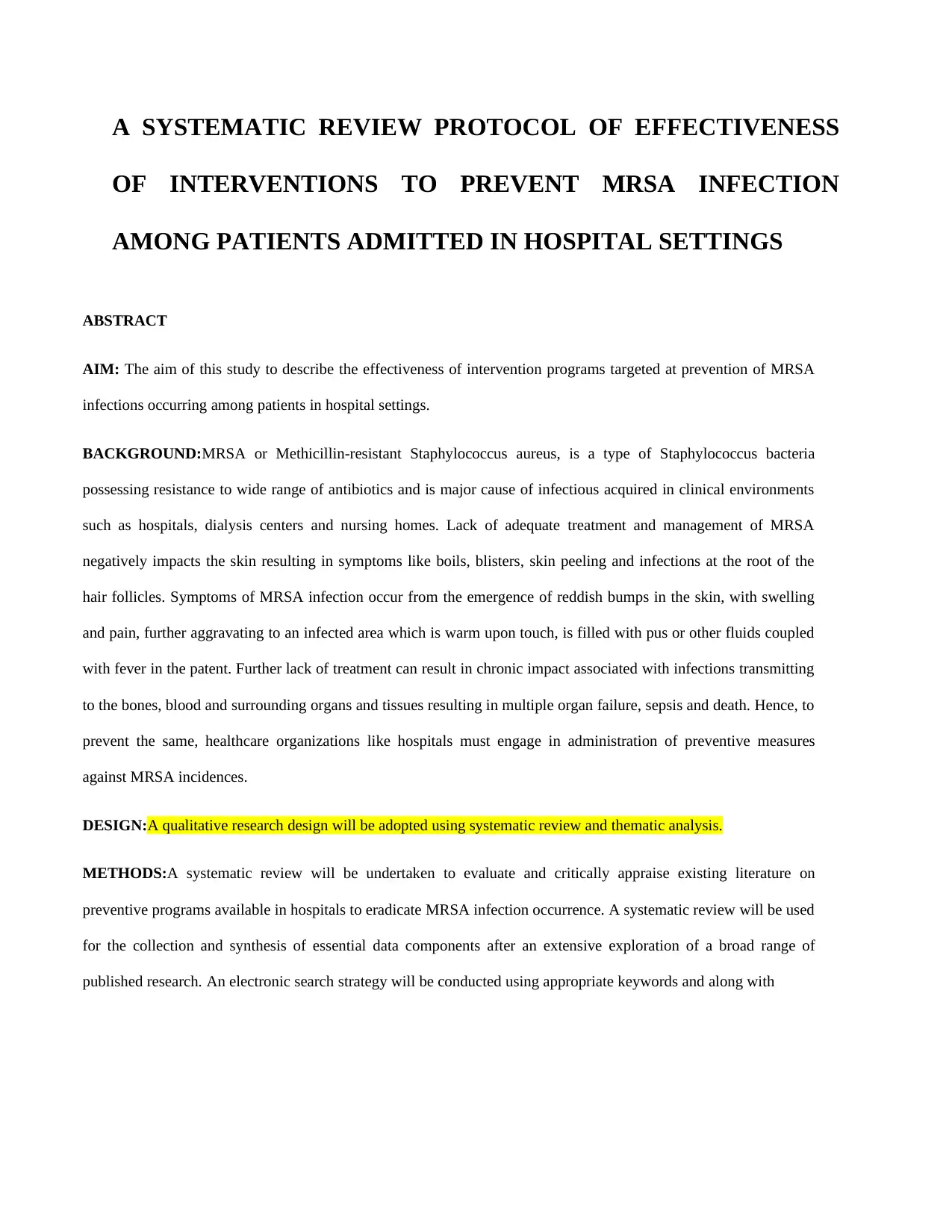
A SYSTEMATIC REVIEW PROTOCOL OF EFFECTIVENESS
OF INTERVENTIONS TO PREVENT MRSA INFECTION
AMONG PATIENTS ADMITTED IN HOSPITAL SETTINGS
ABSTRACT
AIM: The aim of this study to describe the effectiveness of intervention programs targeted at prevention of MRSA
infections occurring among patients in hospital settings.
BACKGROUND:MRSA or Methicillin-resistant Staphylococcus aureus, is a type of Staphylococcus bacteria
possessing resistance to wide range of antibiotics and is major cause of infectious acquired in clinical environments
such as hospitals, dialysis centers and nursing homes. Lack of adequate treatment and management of MRSA
negatively impacts the skin resulting in symptoms like boils, blisters, skin peeling and infections at the root of the
hair follicles. Symptoms of MRSA infection occur from the emergence of reddish bumps in the skin, with swelling
and pain, further aggravating to an infected area which is warm upon touch, is filled with pus or other fluids coupled
with fever in the patent. Further lack of treatment can result in chronic impact associated with infections transmitting
to the bones, blood and surrounding organs and tissues resulting in multiple organ failure, sepsis and death. Hence, to
prevent the same, healthcare organizations like hospitals must engage in administration of preventive measures
against MRSA incidences.
DESIGN:A qualitative research design will be adopted using systematic review and thematic analysis.
METHODS:A systematic review will be undertaken to evaluate and critically appraise existing literature on
preventive programs available in hospitals to eradicate MRSA infection occurrence. A systematic review will be used
for the collection and synthesis of essential data components after an extensive exploration of a broad range of
published research. An electronic search strategy will be conducted using appropriate keywords and along with
OF INTERVENTIONS TO PREVENT MRSA INFECTION
AMONG PATIENTS ADMITTED IN HOSPITAL SETTINGS
ABSTRACT
AIM: The aim of this study to describe the effectiveness of intervention programs targeted at prevention of MRSA
infections occurring among patients in hospital settings.
BACKGROUND:MRSA or Methicillin-resistant Staphylococcus aureus, is a type of Staphylococcus bacteria
possessing resistance to wide range of antibiotics and is major cause of infectious acquired in clinical environments
such as hospitals, dialysis centers and nursing homes. Lack of adequate treatment and management of MRSA
negatively impacts the skin resulting in symptoms like boils, blisters, skin peeling and infections at the root of the
hair follicles. Symptoms of MRSA infection occur from the emergence of reddish bumps in the skin, with swelling
and pain, further aggravating to an infected area which is warm upon touch, is filled with pus or other fluids coupled
with fever in the patent. Further lack of treatment can result in chronic impact associated with infections transmitting
to the bones, blood and surrounding organs and tissues resulting in multiple organ failure, sepsis and death. Hence, to
prevent the same, healthcare organizations like hospitals must engage in administration of preventive measures
against MRSA incidences.
DESIGN:A qualitative research design will be adopted using systematic review and thematic analysis.
METHODS:A systematic review will be undertaken to evaluate and critically appraise existing literature on
preventive programs available in hospitals to eradicate MRSA infection occurrence. A systematic review will be used
for the collection and synthesis of essential data components after an extensive exploration of a broad range of
published research. An electronic search strategy will be conducted using appropriate keywords and along with
Paraphrase This Document
Need a fresh take? Get an instant paraphrase of this document with our AI Paraphraser
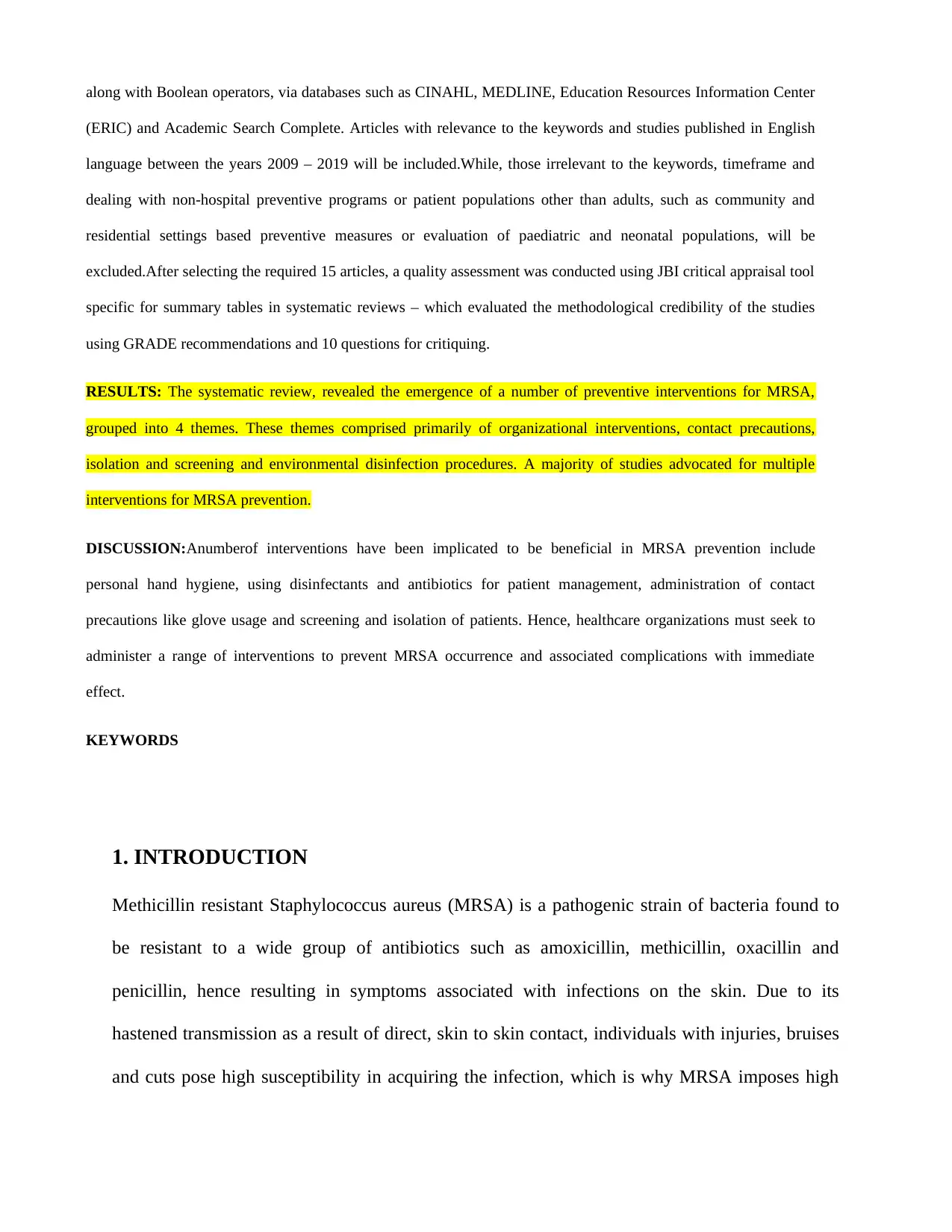
1. INTRODUCTION
Methicillin resistant Staphylococcus aureus (MRSA) is a pathogenic strain of bacteria found to
be resistant to a wide group of antibiotics such as amoxicillin, methicillin, oxacillin and
penicillin, hence resulting in symptoms associated with infections on the skin. Due to its
hastened transmission as a result of direct, skin to skin contact, individuals with injuries, bruises
and cuts pose high susceptibility in acquiring the infection, which is why MRSA imposes high
along with Boolean operators, via databases such as CINAHL, MEDLINE, Education Resources Information Center
(ERIC) and Academic Search Complete. Articles with relevance to the keywords and studies published in English
language between the years 2009 – 2019 will be included.While, those irrelevant to the keywords, timeframe and
dealing with non-hospital preventive programs or patient populations other than adults, such as community and
residential settings based preventive measures or evaluation of paediatric and neonatal populations, will be
excluded.After selecting the required 15 articles, a quality assessment was conducted using JBI critical appraisal tool
specific for summary tables in systematic reviews – which evaluated the methodological credibility of the studies
using GRADE recommendations and 10 questions for critiquing.
RESULTS: The systematic review, revealed the emergence of a number of preventive interventions for MRSA,
grouped into 4 themes. These themes comprised primarily of organizational interventions, contact precautions,
isolation and screening and environmental disinfection procedures. A majority of studies advocated for multiple
interventions for MRSA prevention.
DISCUSSION:Anumberof interventions have been implicated to be beneficial in MRSA prevention include
personal hand hygiene, using disinfectants and antibiotics for patient management, administration of contact
precautions like glove usage and screening and isolation of patients. Hence, healthcare organizations must seek to
administer a range of interventions to prevent MRSA occurrence and associated complications with immediate
effect.
KEYWORDS
Methicillin resistant Staphylococcus aureus (MRSA) is a pathogenic strain of bacteria found to
be resistant to a wide group of antibiotics such as amoxicillin, methicillin, oxacillin and
penicillin, hence resulting in symptoms associated with infections on the skin. Due to its
hastened transmission as a result of direct, skin to skin contact, individuals with injuries, bruises
and cuts pose high susceptibility in acquiring the infection, which is why MRSA imposes high
along with Boolean operators, via databases such as CINAHL, MEDLINE, Education Resources Information Center
(ERIC) and Academic Search Complete. Articles with relevance to the keywords and studies published in English
language between the years 2009 – 2019 will be included.While, those irrelevant to the keywords, timeframe and
dealing with non-hospital preventive programs or patient populations other than adults, such as community and
residential settings based preventive measures or evaluation of paediatric and neonatal populations, will be
excluded.After selecting the required 15 articles, a quality assessment was conducted using JBI critical appraisal tool
specific for summary tables in systematic reviews – which evaluated the methodological credibility of the studies
using GRADE recommendations and 10 questions for critiquing.
RESULTS: The systematic review, revealed the emergence of a number of preventive interventions for MRSA,
grouped into 4 themes. These themes comprised primarily of organizational interventions, contact precautions,
isolation and screening and environmental disinfection procedures. A majority of studies advocated for multiple
interventions for MRSA prevention.
DISCUSSION:Anumberof interventions have been implicated to be beneficial in MRSA prevention include
personal hand hygiene, using disinfectants and antibiotics for patient management, administration of contact
precautions like glove usage and screening and isolation of patients. Hence, healthcare organizations must seek to
administer a range of interventions to prevent MRSA occurrence and associated complications with immediate
effect.
KEYWORDS
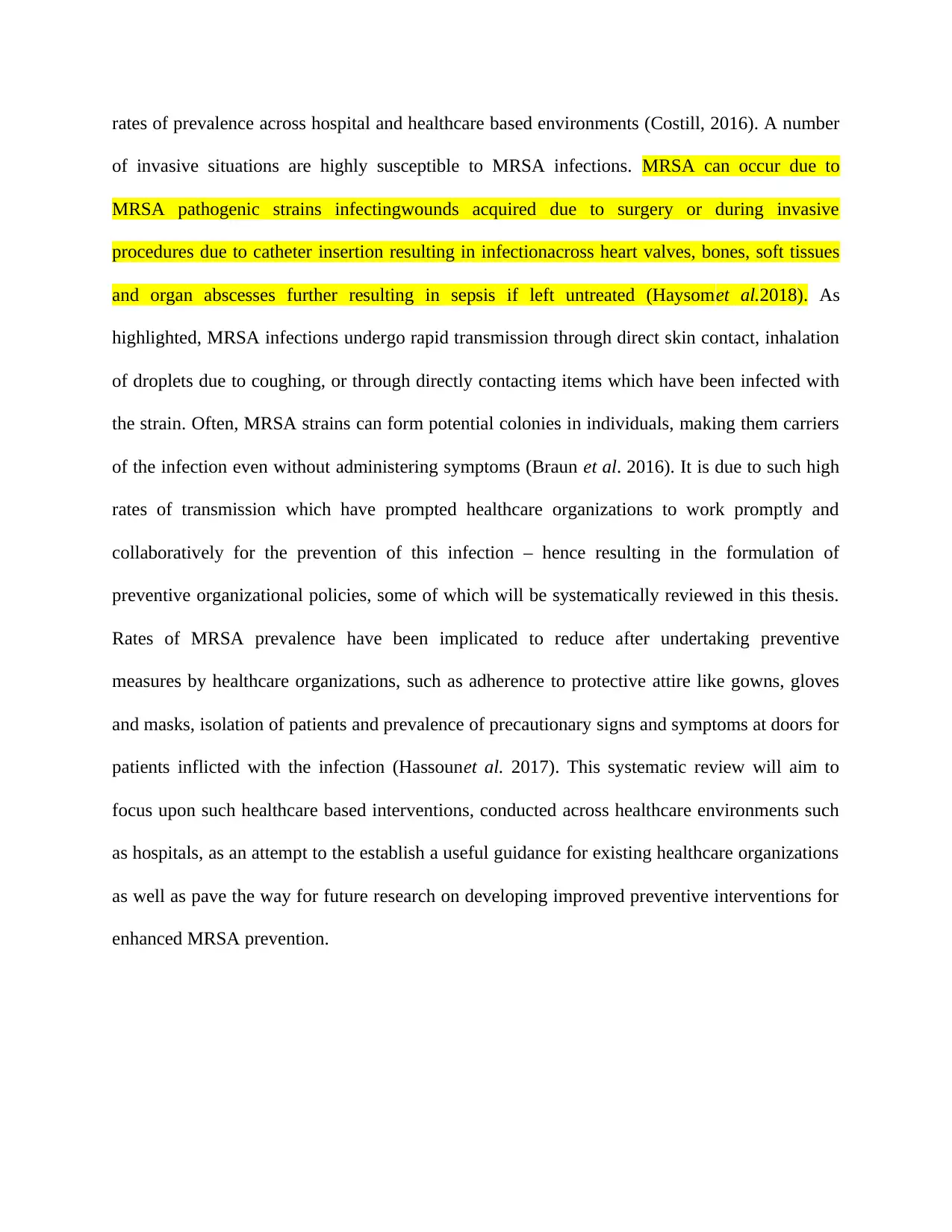
rates of prevalence across hospital and healthcare based environments (Costill, 2016). A number
of invasive situations are highly susceptible to MRSA infections. MRSA can occur due to
MRSA pathogenic strains infectingwounds acquired due to surgery or during invasive
procedures due to catheter insertion resulting in infectionacross heart valves, bones, soft tissues
and organ abscesses further resulting in sepsis if left untreated (Haysomet al.2018). As
highlighted, MRSA infections undergo rapid transmission through direct skin contact, inhalation
of droplets due to coughing, or through directly contacting items which have been infected with
the strain. Often, MRSA strains can form potential colonies in individuals, making them carriers
of the infection even without administering symptoms (Braun et al. 2016). It is due to such high
rates of transmission which have prompted healthcare organizations to work promptly and
collaboratively for the prevention of this infection – hence resulting in the formulation of
preventive organizational policies, some of which will be systematically reviewed in this thesis.
Rates of MRSA prevalence have been implicated to reduce after undertaking preventive
measures by healthcare organizations, such as adherence to protective attire like gowns, gloves
and masks, isolation of patients and prevalence of precautionary signs and symptoms at doors for
patients inflicted with the infection (Hassounet al. 2017). This systematic review will aim to
focus upon such healthcare based interventions, conducted across healthcare environments such
as hospitals, as an attempt to the establish a useful guidance for existing healthcare organizations
as well as pave the way for future research on developing improved preventive interventions for
enhanced MRSA prevention.
of invasive situations are highly susceptible to MRSA infections. MRSA can occur due to
MRSA pathogenic strains infectingwounds acquired due to surgery or during invasive
procedures due to catheter insertion resulting in infectionacross heart valves, bones, soft tissues
and organ abscesses further resulting in sepsis if left untreated (Haysomet al.2018). As
highlighted, MRSA infections undergo rapid transmission through direct skin contact, inhalation
of droplets due to coughing, or through directly contacting items which have been infected with
the strain. Often, MRSA strains can form potential colonies in individuals, making them carriers
of the infection even without administering symptoms (Braun et al. 2016). It is due to such high
rates of transmission which have prompted healthcare organizations to work promptly and
collaboratively for the prevention of this infection – hence resulting in the formulation of
preventive organizational policies, some of which will be systematically reviewed in this thesis.
Rates of MRSA prevalence have been implicated to reduce after undertaking preventive
measures by healthcare organizations, such as adherence to protective attire like gowns, gloves
and masks, isolation of patients and prevalence of precautionary signs and symptoms at doors for
patients inflicted with the infection (Hassounet al. 2017). This systematic review will aim to
focus upon such healthcare based interventions, conducted across healthcare environments such
as hospitals, as an attempt to the establish a useful guidance for existing healthcare organizations
as well as pave the way for future research on developing improved preventive interventions for
enhanced MRSA prevention.
⊘ This is a preview!⊘
Do you want full access?
Subscribe today to unlock all pages.

Trusted by 1+ million students worldwide
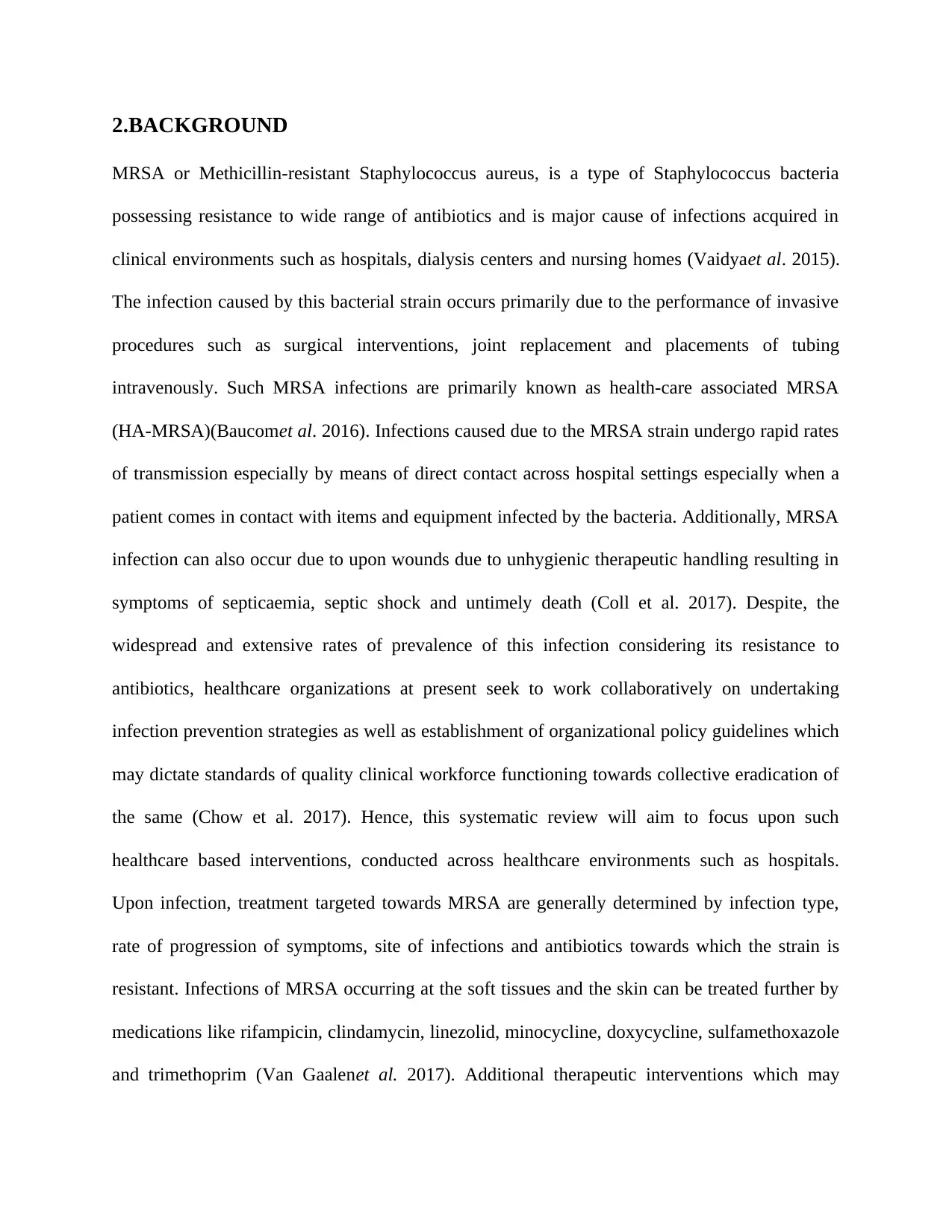
2.BACKGROUND
MRSA or Methicillin-resistant Staphylococcus aureus, is a type of Staphylococcus bacteria
possessing resistance to wide range of antibiotics and is major cause of infections acquired in
clinical environments such as hospitals, dialysis centers and nursing homes (Vaidyaet al. 2015).
The infection caused by this bacterial strain occurs primarily due to the performance of invasive
procedures such as surgical interventions, joint replacement and placements of tubing
intravenously. Such MRSA infections are primarily known as health-care associated MRSA
(HA-MRSA)(Baucomet al. 2016). Infections caused due to the MRSA strain undergo rapid rates
of transmission especially by means of direct contact across hospital settings especially when a
patient comes in contact with items and equipment infected by the bacteria. Additionally, MRSA
infection can also occur due to upon wounds due to unhygienic therapeutic handling resulting in
symptoms of septicaemia, septic shock and untimely death (Coll et al. 2017). Despite, the
widespread and extensive rates of prevalence of this infection considering its resistance to
antibiotics, healthcare organizations at present seek to work collaboratively on undertaking
infection prevention strategies as well as establishment of organizational policy guidelines which
may dictate standards of quality clinical workforce functioning towards collective eradication of
the same (Chow et al. 2017). Hence, this systematic review will aim to focus upon such
healthcare based interventions, conducted across healthcare environments such as hospitals.
Upon infection, treatment targeted towards MRSA are generally determined by infection type,
rate of progression of symptoms, site of infections and antibiotics towards which the strain is
resistant. Infections of MRSA occurring at the soft tissues and the skin can be treated further by
medications like rifampicin, clindamycin, linezolid, minocycline, doxycycline, sulfamethoxazole
and trimethoprim (Van Gaalenet al. 2017). Additional therapeutic interventions which may
MRSA or Methicillin-resistant Staphylococcus aureus, is a type of Staphylococcus bacteria
possessing resistance to wide range of antibiotics and is major cause of infections acquired in
clinical environments such as hospitals, dialysis centers and nursing homes (Vaidyaet al. 2015).
The infection caused by this bacterial strain occurs primarily due to the performance of invasive
procedures such as surgical interventions, joint replacement and placements of tubing
intravenously. Such MRSA infections are primarily known as health-care associated MRSA
(HA-MRSA)(Baucomet al. 2016). Infections caused due to the MRSA strain undergo rapid rates
of transmission especially by means of direct contact across hospital settings especially when a
patient comes in contact with items and equipment infected by the bacteria. Additionally, MRSA
infection can also occur due to upon wounds due to unhygienic therapeutic handling resulting in
symptoms of septicaemia, septic shock and untimely death (Coll et al. 2017). Despite, the
widespread and extensive rates of prevalence of this infection considering its resistance to
antibiotics, healthcare organizations at present seek to work collaboratively on undertaking
infection prevention strategies as well as establishment of organizational policy guidelines which
may dictate standards of quality clinical workforce functioning towards collective eradication of
the same (Chow et al. 2017). Hence, this systematic review will aim to focus upon such
healthcare based interventions, conducted across healthcare environments such as hospitals.
Upon infection, treatment targeted towards MRSA are generally determined by infection type,
rate of progression of symptoms, site of infections and antibiotics towards which the strain is
resistant. Infections of MRSA occurring at the soft tissues and the skin can be treated further by
medications like rifampicin, clindamycin, linezolid, minocycline, doxycycline, sulfamethoxazole
and trimethoprim (Van Gaalenet al. 2017). Additional therapeutic interventions which may
Paraphrase This Document
Need a fresh take? Get an instant paraphrase of this document with our AI Paraphraser
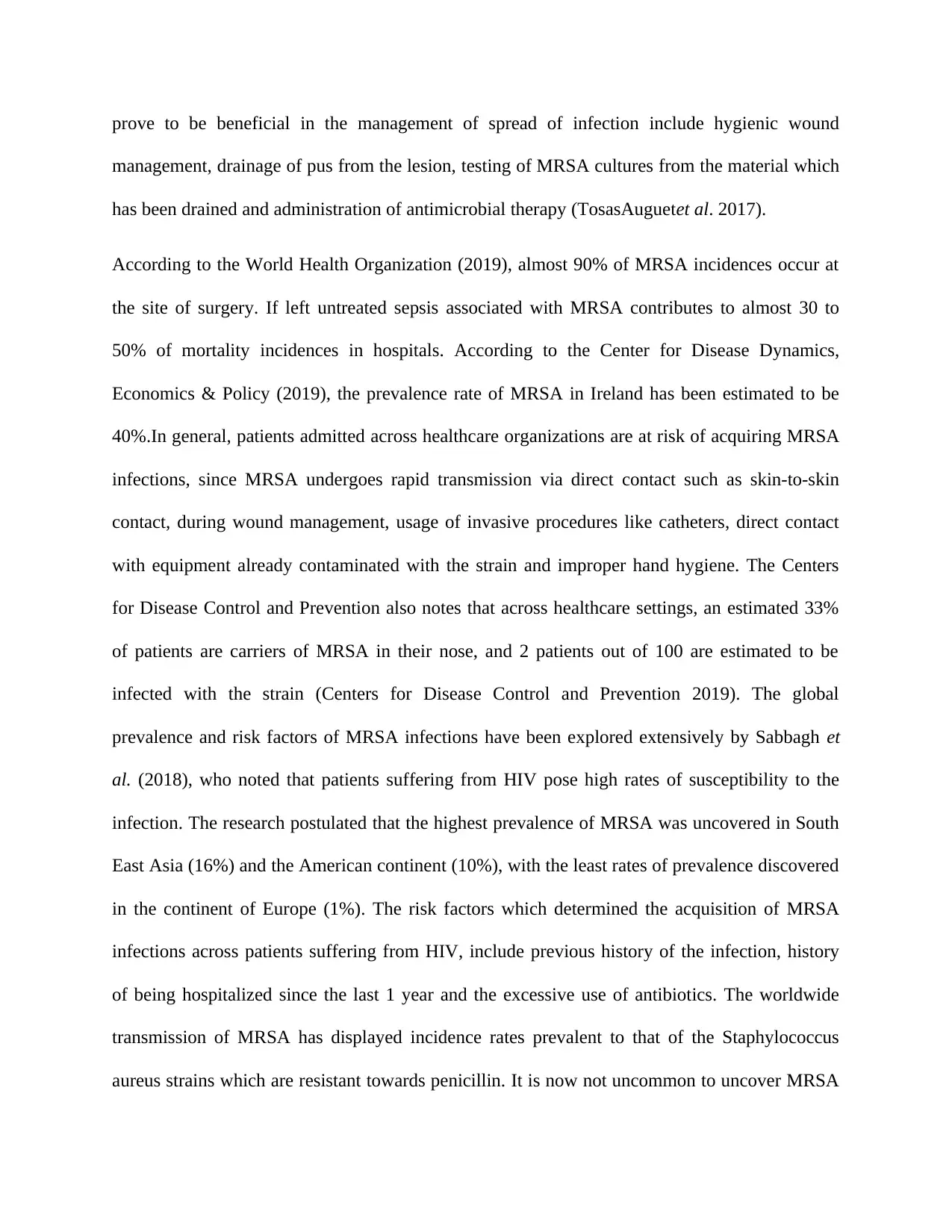
prove to be beneficial in the management of spread of infection include hygienic wound
management, drainage of pus from the lesion, testing of MRSA cultures from the material which
has been drained and administration of antimicrobial therapy (TosasAuguetet al. 2017).
According to the World Health Organization (2019), almost 90% of MRSA incidences occur at
the site of surgery. If left untreated sepsis associated with MRSA contributes to almost 30 to
50% of mortality incidences in hospitals. According to the Center for Disease Dynamics,
Economics & Policy (2019), the prevalence rate of MRSA in Ireland has been estimated to be
40%.In general, patients admitted across healthcare organizations are at risk of acquiring MRSA
infections, since MRSA undergoes rapid transmission via direct contact such as skin-to-skin
contact, during wound management, usage of invasive procedures like catheters, direct contact
with equipment already contaminated with the strain and improper hand hygiene. The Centers
for Disease Control and Prevention also notes that across healthcare settings, an estimated 33%
of patients are carriers of MRSA in their nose, and 2 patients out of 100 are estimated to be
infected with the strain (Centers for Disease Control and Prevention 2019). The global
prevalence and risk factors of MRSA infections have been explored extensively by Sabbagh et
al. (2018), who noted that patients suffering from HIV pose high rates of susceptibility to the
infection. The research postulated that the highest prevalence of MRSA was uncovered in South
East Asia (16%) and the American continent (10%), with the least rates of prevalence discovered
in the continent of Europe (1%). The risk factors which determined the acquisition of MRSA
infections across patients suffering from HIV, include previous history of the infection, history
of being hospitalized since the last 1 year and the excessive use of antibiotics. The worldwide
transmission of MRSA has displayed incidence rates prevalent to that of the Staphylococcus
aureus strains which are resistant towards penicillin. It is now not uncommon to uncover MRSA
management, drainage of pus from the lesion, testing of MRSA cultures from the material which
has been drained and administration of antimicrobial therapy (TosasAuguetet al. 2017).
According to the World Health Organization (2019), almost 90% of MRSA incidences occur at
the site of surgery. If left untreated sepsis associated with MRSA contributes to almost 30 to
50% of mortality incidences in hospitals. According to the Center for Disease Dynamics,
Economics & Policy (2019), the prevalence rate of MRSA in Ireland has been estimated to be
40%.In general, patients admitted across healthcare organizations are at risk of acquiring MRSA
infections, since MRSA undergoes rapid transmission via direct contact such as skin-to-skin
contact, during wound management, usage of invasive procedures like catheters, direct contact
with equipment already contaminated with the strain and improper hand hygiene. The Centers
for Disease Control and Prevention also notes that across healthcare settings, an estimated 33%
of patients are carriers of MRSA in their nose, and 2 patients out of 100 are estimated to be
infected with the strain (Centers for Disease Control and Prevention 2019). The global
prevalence and risk factors of MRSA infections have been explored extensively by Sabbagh et
al. (2018), who noted that patients suffering from HIV pose high rates of susceptibility to the
infection. The research postulated that the highest prevalence of MRSA was uncovered in South
East Asia (16%) and the American continent (10%), with the least rates of prevalence discovered
in the continent of Europe (1%). The risk factors which determined the acquisition of MRSA
infections across patients suffering from HIV, include previous history of the infection, history
of being hospitalized since the last 1 year and the excessive use of antibiotics. The worldwide
transmission of MRSA has displayed incidence rates prevalent to that of the Staphylococcus
aureus strains which are resistant towards penicillin. It is now not uncommon to uncover MRSA
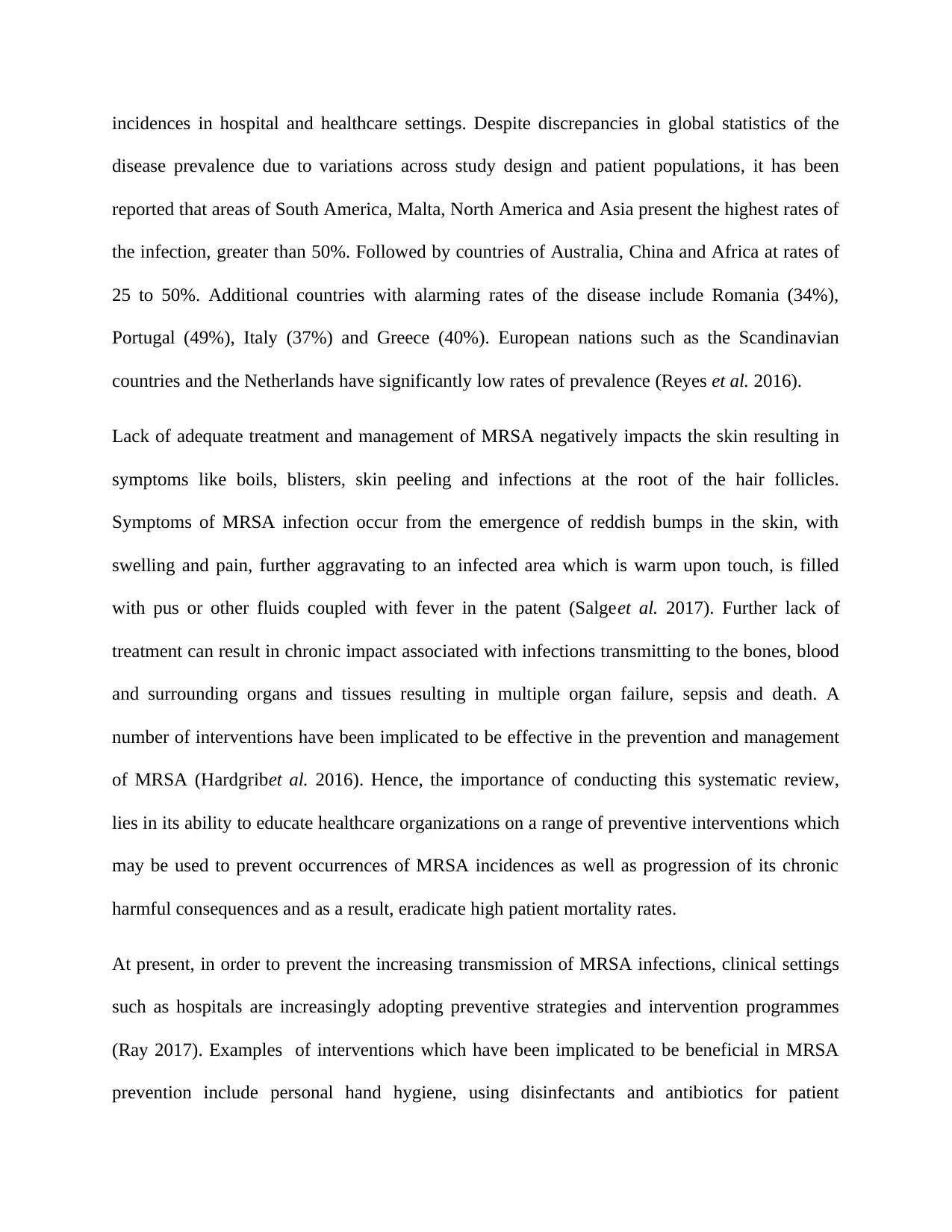
incidences in hospital and healthcare settings. Despite discrepancies in global statistics of the
disease prevalence due to variations across study design and patient populations, it has been
reported that areas of South America, Malta, North America and Asia present the highest rates of
the infection, greater than 50%. Followed by countries of Australia, China and Africa at rates of
25 to 50%. Additional countries with alarming rates of the disease include Romania (34%),
Portugal (49%), Italy (37%) and Greece (40%). European nations such as the Scandinavian
countries and the Netherlands have significantly low rates of prevalence (Reyes et al. 2016).
Lack of adequate treatment and management of MRSA negatively impacts the skin resulting in
symptoms like boils, blisters, skin peeling and infections at the root of the hair follicles.
Symptoms of MRSA infection occur from the emergence of reddish bumps in the skin, with
swelling and pain, further aggravating to an infected area which is warm upon touch, is filled
with pus or other fluids coupled with fever in the patent (Salgeet al. 2017). Further lack of
treatment can result in chronic impact associated with infections transmitting to the bones, blood
and surrounding organs and tissues resulting in multiple organ failure, sepsis and death. A
number of interventions have been implicated to be effective in the prevention and management
of MRSA (Hardgribet al. 2016). Hence, the importance of conducting this systematic review,
lies in its ability to educate healthcare organizations on a range of preventive interventions which
may be used to prevent occurrences of MRSA incidences as well as progression of its chronic
harmful consequences and as a result, eradicate high patient mortality rates.
At present, in order to prevent the increasing transmission of MRSA infections, clinical settings
such as hospitals are increasingly adopting preventive strategies and intervention programmes
(Ray 2017). Examples of interventions which have been implicated to be beneficial in MRSA
prevention include personal hand hygiene, using disinfectants and antibiotics for patient
disease prevalence due to variations across study design and patient populations, it has been
reported that areas of South America, Malta, North America and Asia present the highest rates of
the infection, greater than 50%. Followed by countries of Australia, China and Africa at rates of
25 to 50%. Additional countries with alarming rates of the disease include Romania (34%),
Portugal (49%), Italy (37%) and Greece (40%). European nations such as the Scandinavian
countries and the Netherlands have significantly low rates of prevalence (Reyes et al. 2016).
Lack of adequate treatment and management of MRSA negatively impacts the skin resulting in
symptoms like boils, blisters, skin peeling and infections at the root of the hair follicles.
Symptoms of MRSA infection occur from the emergence of reddish bumps in the skin, with
swelling and pain, further aggravating to an infected area which is warm upon touch, is filled
with pus or other fluids coupled with fever in the patent (Salgeet al. 2017). Further lack of
treatment can result in chronic impact associated with infections transmitting to the bones, blood
and surrounding organs and tissues resulting in multiple organ failure, sepsis and death. A
number of interventions have been implicated to be effective in the prevention and management
of MRSA (Hardgribet al. 2016). Hence, the importance of conducting this systematic review,
lies in its ability to educate healthcare organizations on a range of preventive interventions which
may be used to prevent occurrences of MRSA incidences as well as progression of its chronic
harmful consequences and as a result, eradicate high patient mortality rates.
At present, in order to prevent the increasing transmission of MRSA infections, clinical settings
such as hospitals are increasingly adopting preventive strategies and intervention programmes
(Ray 2017). Examples of interventions which have been implicated to be beneficial in MRSA
prevention include personal hand hygiene, using disinfectants and antibiotics for patient
⊘ This is a preview!⊘
Do you want full access?
Subscribe today to unlock all pages.

Trusted by 1+ million students worldwide
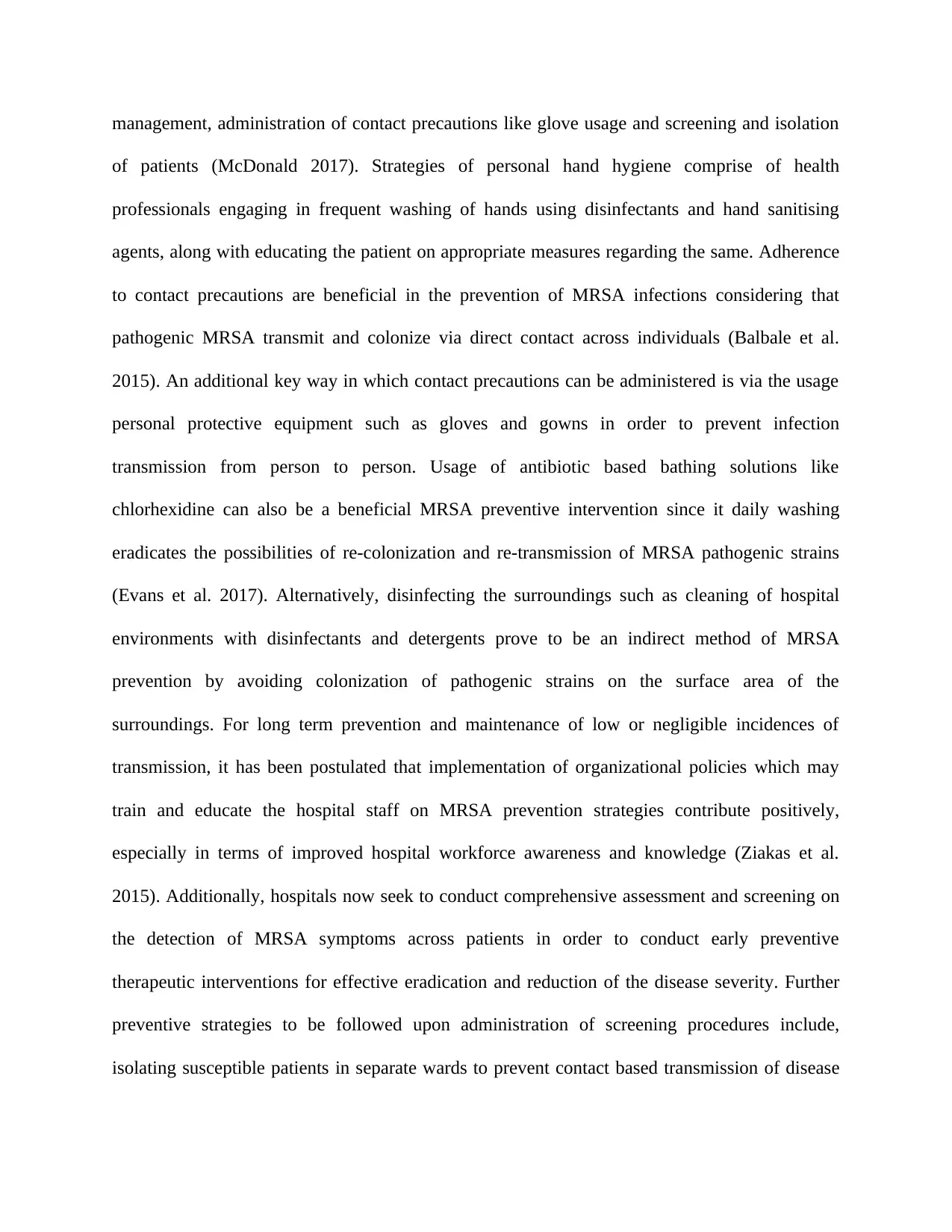
management, administration of contact precautions like glove usage and screening and isolation
of patients (McDonald 2017). Strategies of personal hand hygiene comprise of health
professionals engaging in frequent washing of hands using disinfectants and hand sanitising
agents, along with educating the patient on appropriate measures regarding the same. Adherence
to contact precautions are beneficial in the prevention of MRSA infections considering that
pathogenic MRSA transmit and colonize via direct contact across individuals (Balbale et al.
2015). An additional key way in which contact precautions can be administered is via the usage
personal protective equipment such as gloves and gowns in order to prevent infection
transmission from person to person. Usage of antibiotic based bathing solutions like
chlorhexidine can also be a beneficial MRSA preventive intervention since it daily washing
eradicates the possibilities of re-colonization and re-transmission of MRSA pathogenic strains
(Evans et al. 2017). Alternatively, disinfecting the surroundings such as cleaning of hospital
environments with disinfectants and detergents prove to be an indirect method of MRSA
prevention by avoiding colonization of pathogenic strains on the surface area of the
surroundings. For long term prevention and maintenance of low or negligible incidences of
transmission, it has been postulated that implementation of organizational policies which may
train and educate the hospital staff on MRSA prevention strategies contribute positively,
especially in terms of improved hospital workforce awareness and knowledge (Ziakas et al.
2015). Additionally, hospitals now seek to conduct comprehensive assessment and screening on
the detection of MRSA symptoms across patients in order to conduct early preventive
therapeutic interventions for effective eradication and reduction of the disease severity. Further
preventive strategies to be followed upon administration of screening procedures include,
isolating susceptible patients in separate wards to prevent contact based transmission of disease
of patients (McDonald 2017). Strategies of personal hand hygiene comprise of health
professionals engaging in frequent washing of hands using disinfectants and hand sanitising
agents, along with educating the patient on appropriate measures regarding the same. Adherence
to contact precautions are beneficial in the prevention of MRSA infections considering that
pathogenic MRSA transmit and colonize via direct contact across individuals (Balbale et al.
2015). An additional key way in which contact precautions can be administered is via the usage
personal protective equipment such as gloves and gowns in order to prevent infection
transmission from person to person. Usage of antibiotic based bathing solutions like
chlorhexidine can also be a beneficial MRSA preventive intervention since it daily washing
eradicates the possibilities of re-colonization and re-transmission of MRSA pathogenic strains
(Evans et al. 2017). Alternatively, disinfecting the surroundings such as cleaning of hospital
environments with disinfectants and detergents prove to be an indirect method of MRSA
prevention by avoiding colonization of pathogenic strains on the surface area of the
surroundings. For long term prevention and maintenance of low or negligible incidences of
transmission, it has been postulated that implementation of organizational policies which may
train and educate the hospital staff on MRSA prevention strategies contribute positively,
especially in terms of improved hospital workforce awareness and knowledge (Ziakas et al.
2015). Additionally, hospitals now seek to conduct comprehensive assessment and screening on
the detection of MRSA symptoms across patients in order to conduct early preventive
therapeutic interventions for effective eradication and reduction of the disease severity. Further
preventive strategies to be followed upon administration of screening procedures include,
isolating susceptible patients in separate wards to prevent contact based transmission of disease
Paraphrase This Document
Need a fresh take? Get an instant paraphrase of this document with our AI Paraphraser
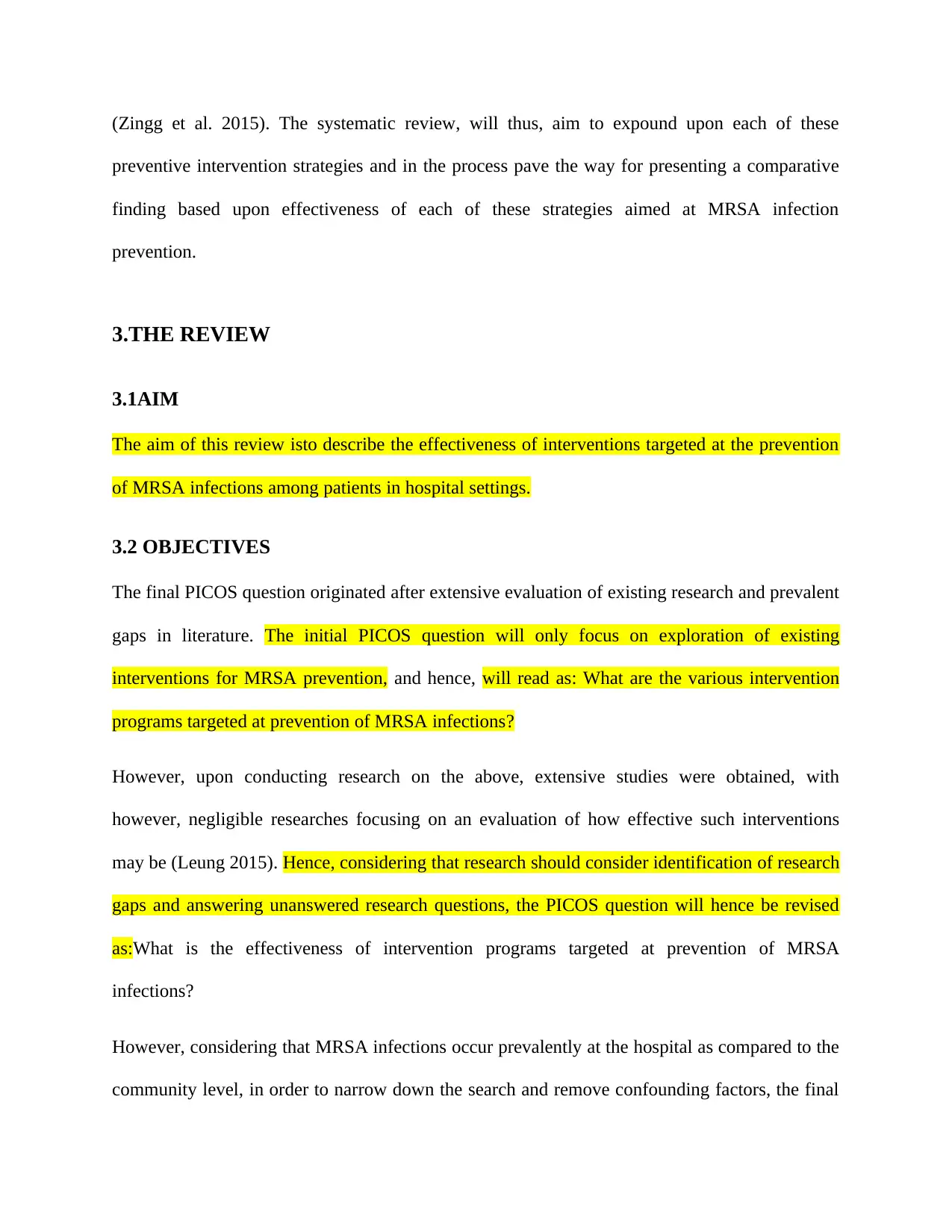
(Zingg et al. 2015). The systematic review, will thus, aim to expound upon each of these
preventive intervention strategies and in the process pave the way for presenting a comparative
finding based upon effectiveness of each of these strategies aimed at MRSA infection
prevention.
3.THE REVIEW
3.1AIM
The aim of this review isto describe the effectiveness of interventions targeted at the prevention
of MRSA infections among patients in hospital settings.
3.2 OBJECTIVES
The final PICOS question originated after extensive evaluation of existing research and prevalent
gaps in literature. The initial PICOS question will only focus on exploration of existing
interventions for MRSA prevention, and hence, will read as: What are the various intervention
programs targeted at prevention of MRSA infections?
However, upon conducting research on the above, extensive studies were obtained, with
however, negligible researches focusing on an evaluation of how effective such interventions
may be (Leung 2015). Hence, considering that research should consider identification of research
gaps and answering unanswered research questions, the PICOS question will hence be revised
as:What is the effectiveness of intervention programs targeted at prevention of MRSA
infections?
However, considering that MRSA infections occur prevalently at the hospital as compared to the
community level, in order to narrow down the search and remove confounding factors, the final
preventive intervention strategies and in the process pave the way for presenting a comparative
finding based upon effectiveness of each of these strategies aimed at MRSA infection
prevention.
3.THE REVIEW
3.1AIM
The aim of this review isto describe the effectiveness of interventions targeted at the prevention
of MRSA infections among patients in hospital settings.
3.2 OBJECTIVES
The final PICOS question originated after extensive evaluation of existing research and prevalent
gaps in literature. The initial PICOS question will only focus on exploration of existing
interventions for MRSA prevention, and hence, will read as: What are the various intervention
programs targeted at prevention of MRSA infections?
However, upon conducting research on the above, extensive studies were obtained, with
however, negligible researches focusing on an evaluation of how effective such interventions
may be (Leung 2015). Hence, considering that research should consider identification of research
gaps and answering unanswered research questions, the PICOS question will hence be revised
as:What is the effectiveness of intervention programs targeted at prevention of MRSA
infections?
However, considering that MRSA infections occur prevalently at the hospital as compared to the
community level, in order to narrow down the search and remove confounding factors, the final
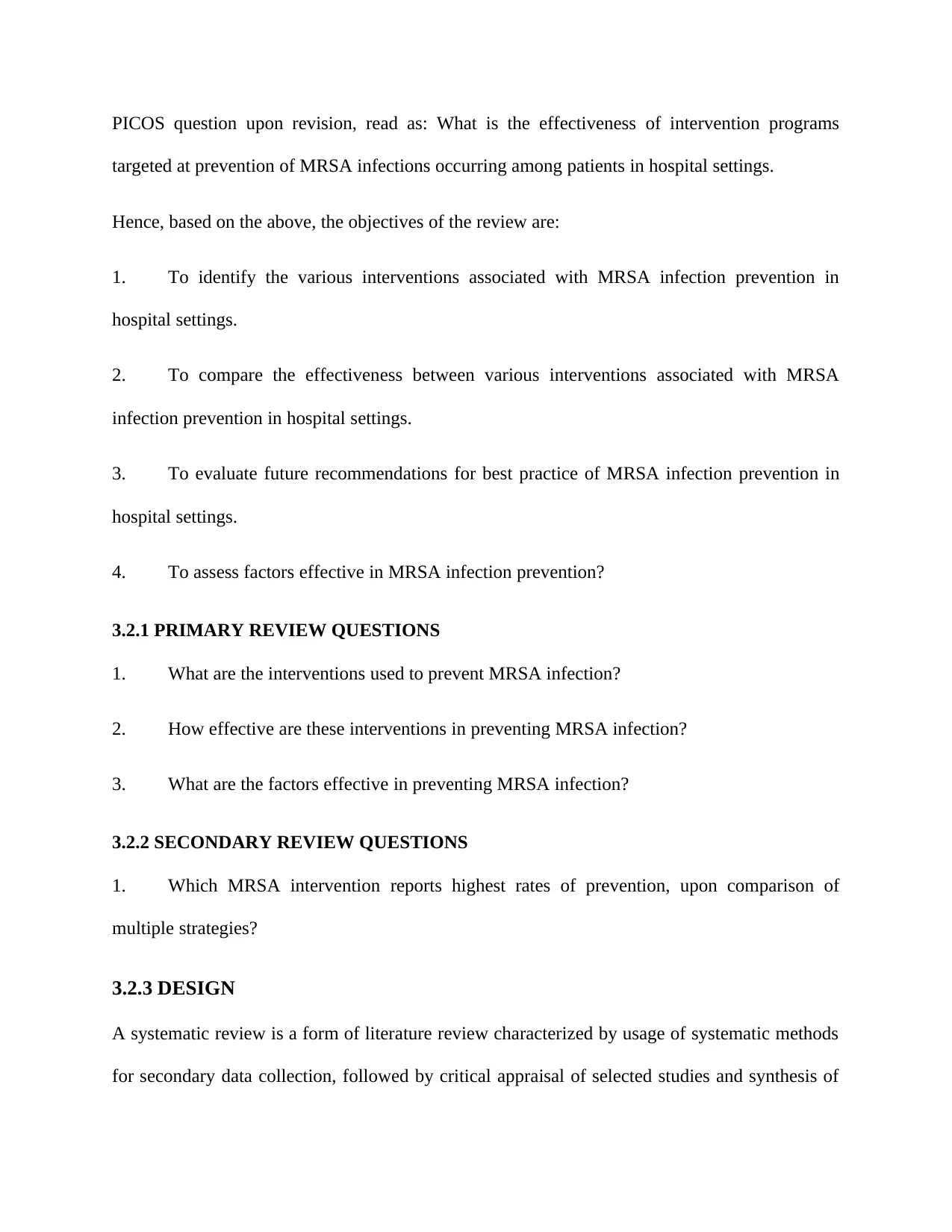
PICOS question upon revision, read as: What is the effectiveness of intervention programs
targeted at prevention of MRSA infections occurring among patients in hospital settings.
Hence, based on the above, the objectives of the review are:
1. To identify the various interventions associated with MRSA infection prevention in
hospital settings.
2. To compare the effectiveness between various interventions associated with MRSA
infection prevention in hospital settings.
3. To evaluate future recommendations for best practice of MRSA infection prevention in
hospital settings.
4. To assess factors effective in MRSA infection prevention?
3.2.1 PRIMARY REVIEW QUESTIONS
1. What are the interventions used to prevent MRSA infection?
2. How effective are these interventions in preventing MRSA infection?
3. What are the factors effective in preventing MRSA infection?
3.2.2 SECONDARY REVIEW QUESTIONS
1. Which MRSA intervention reports highest rates of prevention, upon comparison of
multiple strategies?
3.2.3 DESIGN
A systematic review is a form of literature review characterized by usage of systematic methods
for secondary data collection, followed by critical appraisal of selected studies and synthesis of
targeted at prevention of MRSA infections occurring among patients in hospital settings.
Hence, based on the above, the objectives of the review are:
1. To identify the various interventions associated with MRSA infection prevention in
hospital settings.
2. To compare the effectiveness between various interventions associated with MRSA
infection prevention in hospital settings.
3. To evaluate future recommendations for best practice of MRSA infection prevention in
hospital settings.
4. To assess factors effective in MRSA infection prevention?
3.2.1 PRIMARY REVIEW QUESTIONS
1. What are the interventions used to prevent MRSA infection?
2. How effective are these interventions in preventing MRSA infection?
3. What are the factors effective in preventing MRSA infection?
3.2.2 SECONDARY REVIEW QUESTIONS
1. Which MRSA intervention reports highest rates of prevention, upon comparison of
multiple strategies?
3.2.3 DESIGN
A systematic review is a form of literature review characterized by usage of systematic methods
for secondary data collection, followed by critical appraisal of selected studies and synthesis of
⊘ This is a preview!⊘
Do you want full access?
Subscribe today to unlock all pages.

Trusted by 1+ million students worldwide
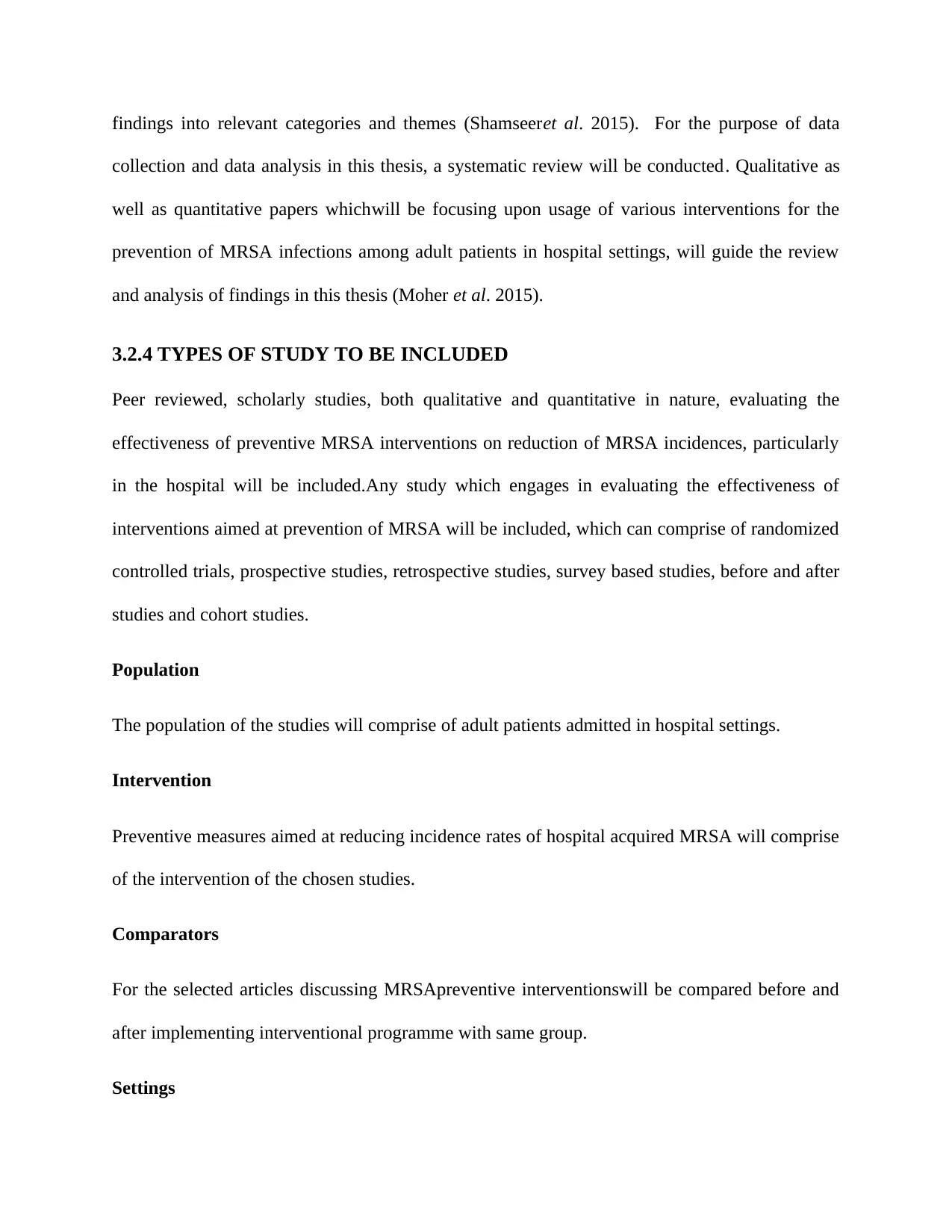
findings into relevant categories and themes (Shamseeret al. 2015). For the purpose of data
collection and data analysis in this thesis, a systematic review will be conducted. Qualitative as
well as quantitative papers whichwill be focusing upon usage of various interventions for the
prevention of MRSA infections among adult patients in hospital settings, will guide the review
and analysis of findings in this thesis (Moher et al. 2015).
3.2.4 TYPES OF STUDY TO BE INCLUDED
Peer reviewed, scholarly studies, both qualitative and quantitative in nature, evaluating the
effectiveness of preventive MRSA interventions on reduction of MRSA incidences, particularly
in the hospital will be included.Any study which engages in evaluating the effectiveness of
interventions aimed at prevention of MRSA will be included, which can comprise of randomized
controlled trials, prospective studies, retrospective studies, survey based studies, before and after
studies and cohort studies.
Population
The population of the studies will comprise of adult patients admitted in hospital settings.
Intervention
Preventive measures aimed at reducing incidence rates of hospital acquired MRSA will comprise
of the intervention of the chosen studies.
Comparators
For the selected articles discussing MRSApreventive interventionswill be compared before and
after implementing interventional programme with same group.
Settings
collection and data analysis in this thesis, a systematic review will be conducted. Qualitative as
well as quantitative papers whichwill be focusing upon usage of various interventions for the
prevention of MRSA infections among adult patients in hospital settings, will guide the review
and analysis of findings in this thesis (Moher et al. 2015).
3.2.4 TYPES OF STUDY TO BE INCLUDED
Peer reviewed, scholarly studies, both qualitative and quantitative in nature, evaluating the
effectiveness of preventive MRSA interventions on reduction of MRSA incidences, particularly
in the hospital will be included.Any study which engages in evaluating the effectiveness of
interventions aimed at prevention of MRSA will be included, which can comprise of randomized
controlled trials, prospective studies, retrospective studies, survey based studies, before and after
studies and cohort studies.
Population
The population of the studies will comprise of adult patients admitted in hospital settings.
Intervention
Preventive measures aimed at reducing incidence rates of hospital acquired MRSA will comprise
of the intervention of the chosen studies.
Comparators
For the selected articles discussing MRSApreventive interventionswill be compared before and
after implementing interventional programme with same group.
Settings
Paraphrase This Document
Need a fresh take? Get an instant paraphrase of this document with our AI Paraphraser
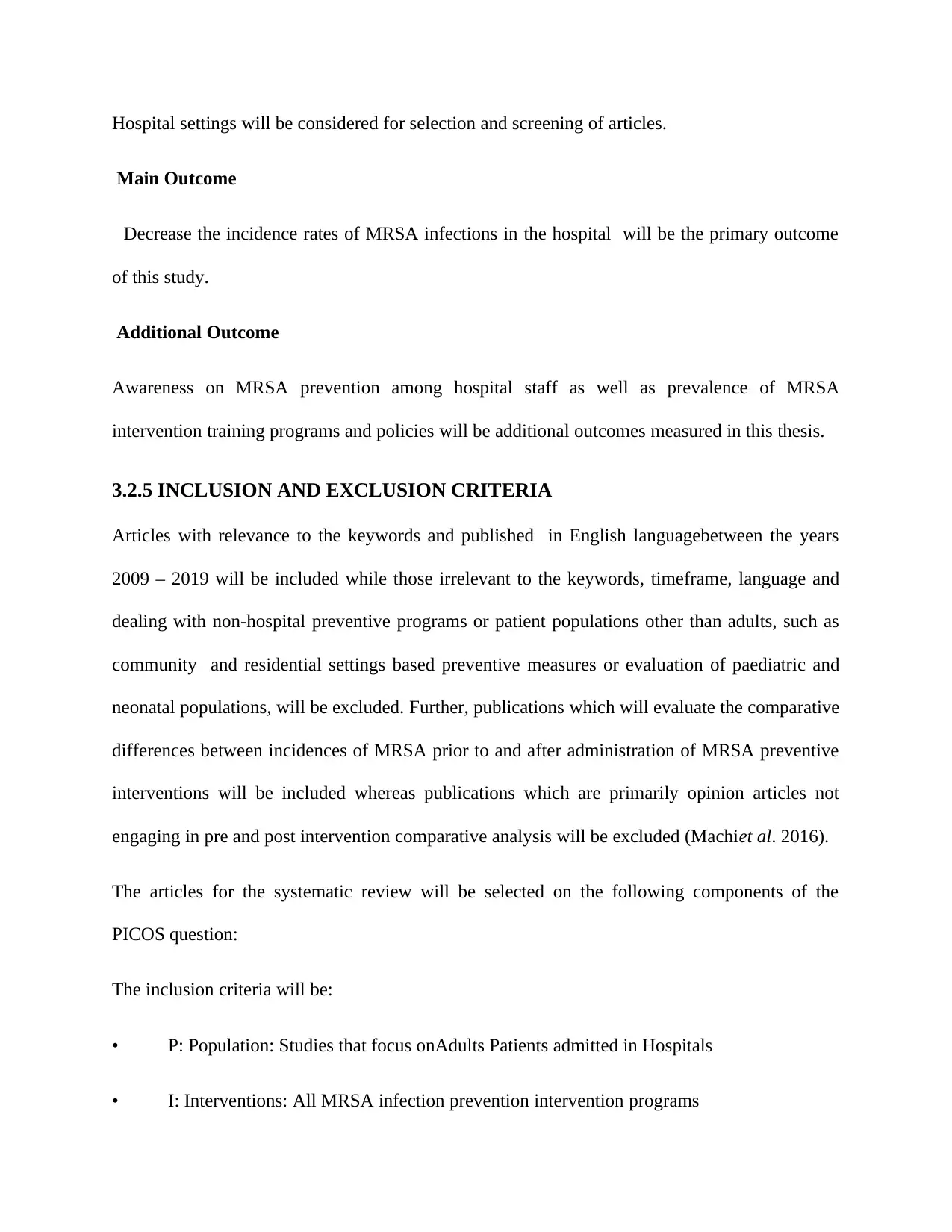
Hospital settings will be considered for selection and screening of articles.
Main Outcome
Decrease the incidence rates of MRSA infections in the hospital will be the primary outcome
of this study.
Additional Outcome
Awareness on MRSA prevention among hospital staff as well as prevalence of MRSA
intervention training programs and policies will be additional outcomes measured in this thesis.
3.2.5 INCLUSION AND EXCLUSION CRITERIA
Articles with relevance to the keywords and published in English languagebetween the years
2009 – 2019 will be included while those irrelevant to the keywords, timeframe, language and
dealing with non-hospital preventive programs or patient populations other than adults, such as
community and residential settings based preventive measures or evaluation of paediatric and
neonatal populations, will be excluded. Further, publications which will evaluate the comparative
differences between incidences of MRSA prior to and after administration of MRSA preventive
interventions will be included whereas publications which are primarily opinion articles not
engaging in pre and post intervention comparative analysis will be excluded (Machiet al. 2016).
The articles for the systematic review will be selected on the following components of the
PICOS question:
The inclusion criteria will be:
• P: Population: Studies that focus onAdults Patients admitted in Hospitals
• I: Interventions: All MRSA infection prevention intervention programs
Main Outcome
Decrease the incidence rates of MRSA infections in the hospital will be the primary outcome
of this study.
Additional Outcome
Awareness on MRSA prevention among hospital staff as well as prevalence of MRSA
intervention training programs and policies will be additional outcomes measured in this thesis.
3.2.5 INCLUSION AND EXCLUSION CRITERIA
Articles with relevance to the keywords and published in English languagebetween the years
2009 – 2019 will be included while those irrelevant to the keywords, timeframe, language and
dealing with non-hospital preventive programs or patient populations other than adults, such as
community and residential settings based preventive measures or evaluation of paediatric and
neonatal populations, will be excluded. Further, publications which will evaluate the comparative
differences between incidences of MRSA prior to and after administration of MRSA preventive
interventions will be included whereas publications which are primarily opinion articles not
engaging in pre and post intervention comparative analysis will be excluded (Machiet al. 2016).
The articles for the systematic review will be selected on the following components of the
PICOS question:
The inclusion criteria will be:
• P: Population: Studies that focus onAdults Patients admitted in Hospitals
• I: Interventions: All MRSA infection prevention intervention programs
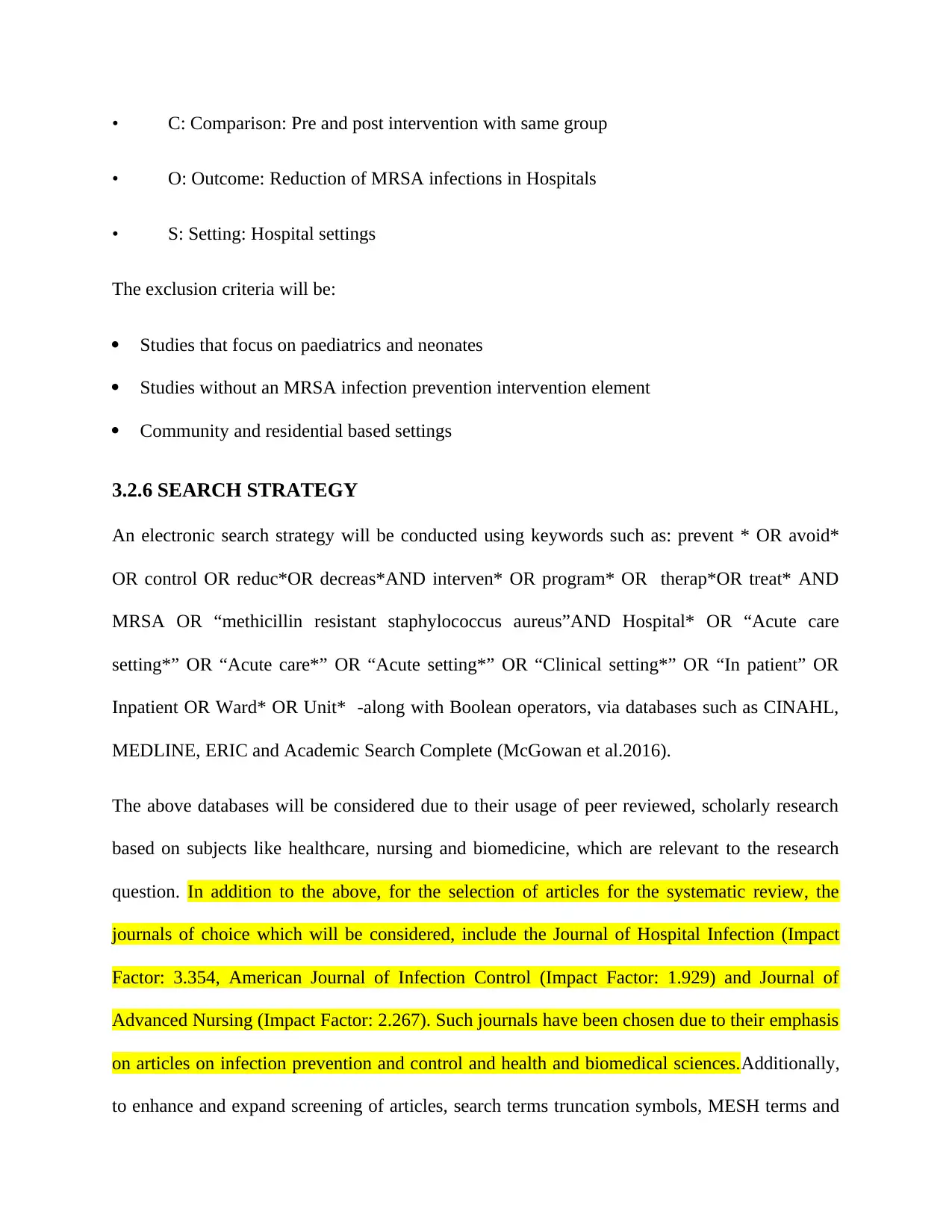
• C: Comparison: Pre and post intervention with same group
• O: Outcome: Reduction of MRSA infections in Hospitals
• S: Setting: Hospital settings
The exclusion criteria will be:
Studies that focus on paediatrics and neonates
Studies without an MRSA infection prevention intervention element
Community and residential based settings
3.2.6 SEARCH STRATEGY
An electronic search strategy will be conducted using keywords such as: prevent * OR avoid*
OR control OR reduc*OR decreas*AND interven* OR program* OR therap*OR treat* AND
MRSA OR “methicillin resistant staphylococcus aureus”AND Hospital* OR “Acute care
setting*” OR “Acute care*” OR “Acute setting*” OR “Clinical setting*” OR “In patient” OR
Inpatient OR Ward* OR Unit* -along with Boolean operators, via databases such as CINAHL,
MEDLINE, ERIC and Academic Search Complete (McGowan et al.2016).
The above databases will be considered due to their usage of peer reviewed, scholarly research
based on subjects like healthcare, nursing and biomedicine, which are relevant to the research
question. In addition to the above, for the selection of articles for the systematic review, the
journals of choice which will be considered, include the Journal of Hospital Infection (Impact
Factor: 3.354, American Journal of Infection Control (Impact Factor: 1.929) and Journal of
Advanced Nursing (Impact Factor: 2.267). Such journals have been chosen due to their emphasis
on articles on infection prevention and control and health and biomedical sciences.Additionally,
to enhance and expand screening of articles, search terms truncation symbols, MESH terms and
• O: Outcome: Reduction of MRSA infections in Hospitals
• S: Setting: Hospital settings
The exclusion criteria will be:
Studies that focus on paediatrics and neonates
Studies without an MRSA infection prevention intervention element
Community and residential based settings
3.2.6 SEARCH STRATEGY
An electronic search strategy will be conducted using keywords such as: prevent * OR avoid*
OR control OR reduc*OR decreas*AND interven* OR program* OR therap*OR treat* AND
MRSA OR “methicillin resistant staphylococcus aureus”AND Hospital* OR “Acute care
setting*” OR “Acute care*” OR “Acute setting*” OR “Clinical setting*” OR “In patient” OR
Inpatient OR Ward* OR Unit* -along with Boolean operators, via databases such as CINAHL,
MEDLINE, ERIC and Academic Search Complete (McGowan et al.2016).
The above databases will be considered due to their usage of peer reviewed, scholarly research
based on subjects like healthcare, nursing and biomedicine, which are relevant to the research
question. In addition to the above, for the selection of articles for the systematic review, the
journals of choice which will be considered, include the Journal of Hospital Infection (Impact
Factor: 3.354, American Journal of Infection Control (Impact Factor: 1.929) and Journal of
Advanced Nursing (Impact Factor: 2.267). Such journals have been chosen due to their emphasis
on articles on infection prevention and control and health and biomedical sciences.Additionally,
to enhance and expand screening of articles, search terms truncation symbols, MESH terms and
⊘ This is a preview!⊘
Do you want full access?
Subscribe today to unlock all pages.

Trusted by 1+ million students worldwide
1 out of 17
Related Documents
Your All-in-One AI-Powered Toolkit for Academic Success.
+13062052269
info@desklib.com
Available 24*7 on WhatsApp / Email
![[object Object]](/_next/static/media/star-bottom.7253800d.svg)
Unlock your academic potential
Copyright © 2020–2025 A2Z Services. All Rights Reserved. Developed and managed by ZUCOL.





